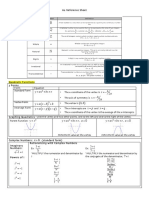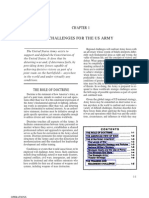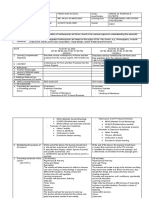Basic (1) Math
Uploaded by
Ian KrebsBasic (1) Math
Uploaded by
Ian KrebsBasic Maths Summary
Algebra: ax
2
+ bx + c = 0 x =
b
b
2
4ac
2a
Geometry
Triangle: the law of cosines
c
2
= a
2
+ b
2
2ab cos Area=
1
2
(base)(height)
Parallelogram: Area=(base)(height)
Circle: center (h, k), radius r
(x h)
2
+ (y k)
2
= r
2
Area=r
2
Circumference s = 2r
Ellipse: center (h, k), axes a, b
_
x h
a
_
2
+
_
y k
b
_
2
= 1
Hyperbola: center (h, k), axes a, b
_
x h
a
_
2
_
y k
b
_
2
= 1
Parabola: tip (h, k)
y = a(x h)
2
+ k
Volumes
Cylinder Volume=(base area)(height)
Cone Volume=
1
3
(base area)(height)
Sphere Volume=(4/3)r
3
SurfaceArea = 4r
2
Vectors, Matrices, and Linear Algebra
Multiplication: Row column
1
_
a b
c d
__
x z
y w
_
=
_
ax + by az + bw
cx + dy cz + dw
_
Determinants
a b
c d
= ad bc
Cramers rule
2
to solve linear system Ax = f
_
a b
c d
__
x
y
_
=
_
e
f
_
x =
e b
f d
a b
c d
y =
a e
c f
a b
c d
Inverse matrix: Ax = f x = A
1
f
A
1
=
_
a b
c d
_
1
=
1
ad bc
_
d b
c a
_
Trig
Identities
sin
2
x + cos
2
x = 1 sec
2
x = 1 + tan
2
x
tan x = sin x/ cos x sec x = 1/ cos x
cot x = cos x/ sin x csc x = 1/ sin x
Complementary angles
sin x = cos(/2 x) cos x = sin(/2 x)
tan x = cot(/2 x) cot x = tan(/2 x)
sec x = csc(/2 x) csc x = sec(/2 x)
Addition formulas
sin(x + y) = sin xcos y + cos xsin y
cos(x + y) = cos xcos y sin xsin y
Half-angle formulas (from cos(x + x))
cos
2
x =
1 + cos(2x)
2
sin
2
x =
1 cos(2x)
2
Product formulas (from Addition formulas)
sin xcos y =
1
2
(sin(x + y) + sin(x y))
sin(2x) = 2 sin xcos x cos(2x) = 2 cos
2
x 1
Derivatives
(d/dx) sin x = cos x (d/dx) cos x = sin x
(d/dx) tan x = sec
2
x (d/dx) sec x = sec xtan x
(d/dx) sin
1
x =
1
1 x
2
(d/dx) tan
1
x =
1
1 + x
2
Integrals
_
sin
m
xcos
n
xdx
Via u-Substitution: if m = odd, then let u = cos x
if n = odd, then let u = sin x
sec x and tan x integrals
3
: SET, TOS, sec
2
x = 1 +tan
2
x
Polar coordinates
x = r cos y = r sin
r =
_
x
2
+ y
2
= arctan(y/x)
Logs, Exponentials
Notations
ln x = log x = log
e
x
Properties
ln(xy) = ln x + ln y e
x+y
= e
x
e
y
ln(x
a
) = a ln x e
ax
= (e
x
)
a
b
a
= e
a ln b
e
ln x
= ln (e
x
) = x
Integrals
_
du
u
= ln |u| + C
_
e
au
du =
1
a
e
au
+ C
Hyperbolic Trig
cosh x =
e
x
+ e
x
2
sinh x =
e
x
e
x
2
Identity
cosh
2
x sinh
2
x = 1
Derivatives
(d/dx) cosh x = sinh x (d/dx) sinh x = cosh x
Integrals
_
cosh xdx = sinhx + C
_
sinh xdx = cosh x + C
1
Examples given for 2 2
2
The formula for the solution is: n
th
variable = (det with n
th
column replaced by RHS) divided by (det of LHS matrix).
3
u =Sec if Even power of Tan and u =Tan if Odd power of Sec.
Limits
Function f(x) is continuous at x = a if
lim
xa
f(x) = lim
xa
+
f(x) = lim
xa
f(x) = f(a)
If all the limits exist, then
lim
xa
[f(x) + g(x)] =
_
lim
xa
f(x)
_
+
_
lim
xa
g(x)
_
lim
xa
f(x)g(x) =
_
lim
xa
f(x)
_ _
lim
xa
g(x)
_
lim
xa
f(x)
g(x)
=
_
lim
xa
f(x)
_
_
_
lim
xa
g(x)
_
lim
xa
f(g(x)) = f
_
lim
xa
g(x)
_
LHospitals rule: if f(a)/g(a) = 0/0 or /, then
lim
xa
f(x)
g(x)
= lim
xa
f
(x)
g
(x)
Dierential Calculus
Limit denition of derivative for y = f(x)
dy
dx
= f
(x) = lim
h0
f(x + h) f(x)
h
Power rule: y = x
r
dy
dx
= rx
r1
Product rule: y = f(x)g(x)
dy
dx
= f
(x)g(x) + f(x)g
(x)
Quotient rule: y = f(x)/g(x)
dy
dx
=
f
(x)g(x) f(x)g
(x)
g(x)
2
Chain rule: y = f(g(x))
dy
dx
= f
(g(x))g
(x)
Taylor series for f(t) at t = t
0
f(t) =
n=0
1
n!
_
d
n
f
dt
n
t=t
0
_
(t t
0
)
n
Integral Calculus
Fundamental theorem of calculus: if F
(x) = f(x) then
F(x) =
_
x
a
f(t) dt
Anti-derivatives/Indenite integrals
_
f(x) dx = F(x) + C
Denite integrals
_
b
a
f(x) dx = F(b) F(a)
Riemann sum denition of denite integral
_
b
a
f(x) dx = lim
N
_
N
n=0
f(x
n
) x
n
_
Integration by parts
4
_
b
a
u(x)v
(x) dx = u(x)v(x)
b
a
_
b
a
u
(x)v(x) dx
Leibnizs rule
d
dt
_
_
b(t)
a(t)
f(x, t) dx
_
= f(b, t)
db
dt
f(a, t)
da
dt
+
_
b
a
f
t
dx
A table of basic integrals
1)
_
u
n
du =
u
n+1
n + 1
+ C (n = 1)
2)
_
du
u
= ln |u| + C
3)
_
e
u
du = e
u
+ C
4)
_
cos udu = sin u + C
5)
_
sin udu = cos u + C
6)
_
du
1 u
2
= sin
1
u + C
7)
_
du
1 + u
2
= tan
1
u + C
8)
_
sec
2
udu = tan u + C
9)
_
sec utan udu = sec u + C
10)
_
sec udu = ln | sec u + tan u| + C
Brief review of methods of integration: u-substitutions, integration by parts, use of trigonometric identities, trigono-
metric substitutions, completing the square, partial fractions...
4
Also known as the integral form of the product rule (uv)
= u
v +uv
uv
= (uv)
v.
You might also like
- Hourglass Workout Program by Luisagiuliet 276% (21)Hourglass Workout Program by Luisagiuliet 251 pages
- The Hold Me Tight Workbook - Dr. Sue Johnson100% (16)The Hold Me Tight Workbook - Dr. Sue Johnson187 pages
- Read People Like A Book by Patrick King-Edited62% (65)Read People Like A Book by Patrick King-Edited12 pages
- Livingood, Blake - Livingood Daily Your 21-Day Guide To Experience Real Health77% (13)Livingood, Blake - Livingood Daily Your 21-Day Guide To Experience Real Health260 pages
- COSMIC CONSCIOUSNESS OF HUMANITY - PROBLEMS OF NEW COSMOGONY (V.P.Kaznacheev,. Л. V. Trofimov.)94% (212)COSMIC CONSCIOUSNESS OF HUMANITY - PROBLEMS OF NEW COSMOGONY (V.P.Kaznacheev,. Л. V. Trofimov.)212 pages
- Donald Trump & Jeffrey Epstein Rape Lawsuit and Affidavits83% (1016)Donald Trump & Jeffrey Epstein Rape Lawsuit and Affidavits13 pages
- The 36 Questions That Lead To Love - The New York Times94% (34)The 36 Questions That Lead To Love - The New York Times3 pages
- The 36 Questions That Lead To Love - The New York Times95% (21)The 36 Questions That Lead To Love - The New York Times3 pages
- Jeffrey Epstein39s Little Black Book Unredacted PDF75% (12)Jeffrey Epstein39s Little Black Book Unredacted PDF95 pages
- The 4 Hour Workweek, Expanded and Updated by Timothy Ferriss - Excerpt23% (954)The 4 Hour Workweek, Expanded and Updated by Timothy Ferriss - Excerpt38 pages
- Warm Up Lesson Presentation Lesson Quiz: Holt Mcdougal Algebra 2 Holt Algebra 2 Holt Mcdougal Algebra 2No ratings yetWarm Up Lesson Presentation Lesson Quiz: Holt Mcdougal Algebra 2 Holt Algebra 2 Holt Mcdougal Algebra 227 pages
- 2007 January Chemistry Paper 5 Edexcel A2No ratings yet2007 January Chemistry Paper 5 Edexcel A216 pages
- De Moiver's Theorem (Trigonometry) Mathematics Question BankFrom EverandDe Moiver's Theorem (Trigonometry) Mathematics Question BankNo ratings yet
- Factoring and Algebra - A Selection of Classic Mathematical Articles Containing Examples and Exercises on the Subject of Algebra (Mathematics Series)From EverandFactoring and Algebra - A Selection of Classic Mathematical Articles Containing Examples and Exercises on the Subject of Algebra (Mathematics Series)No ratings yet
- Application of Derivatives Tangents and Normals (Calculus) Mathematics E-Book For Public ExamsFrom EverandApplication of Derivatives Tangents and Normals (Calculus) Mathematics E-Book For Public Exams5/5 (1)
- Inverse Trigonometric Functions (Trigonometry) Mathematics Question BankFrom EverandInverse Trigonometric Functions (Trigonometry) Mathematics Question BankNo ratings yet
- Acc Math III Unit 2 SE Sequences Series PDFNo ratings yetAcc Math III Unit 2 SE Sequences Series PDF34 pages
- Arithmetic & Geometric Sequence Reminder - IB Mathematics Diploma ProgrammeNo ratings yetArithmetic & Geometric Sequence Reminder - IB Mathematics Diploma Programme2 pages
- Graphs of Reciprocal Functions SolutionsNo ratings yetGraphs of Reciprocal Functions Solutions3 pages
- The Function of Composition and InverseNo ratings yetThe Function of Composition and Inverse20 pages
- Sydney Grammar 2020 Year 10 Maths Yearly & SolutionsNo ratings yetSydney Grammar 2020 Year 10 Maths Yearly & Solutions34 pages
- Amazing Youth Institute Olympiad Math 7th GradeNo ratings yetAmazing Youth Institute Olympiad Math 7th Grade5 pages
- Fall Prep Session Materials 2014-15 DraftNo ratings yetFall Prep Session Materials 2014-15 Draft216 pages
- Fundamentals of Mathematics: Introduction To Logarithm0% (1)Fundamentals of Mathematics: Introduction To Logarithm9 pages
- Chapter 2 Geometrical Applications of Calculus0% (1)Chapter 2 Geometrical Applications of Calculus54 pages
- (Specialist) 2000 Heffernan Exam 1 SolutionsNo ratings yet(Specialist) 2000 Heffernan Exam 1 Solutions14 pages
- Function and Graph: Chapter 1.2 Properties of Function100% (1)Function and Graph: Chapter 1.2 Properties of Function22 pages
- Counting Methods: Permutations CombinationsNo ratings yetCounting Methods: Permutations Combinations31 pages
- MATH 1314-1414 College Algebra and College Algebra For Precalculus Prerequisite ReviewNo ratings yetMATH 1314-1414 College Algebra and College Algebra For Precalculus Prerequisite Review11 pages
- Eliveringhighqualitypublic Services: Budget 2007No ratings yetEliveringhighqualitypublic Services: Budget 200726 pages
- Eetingtheproductivitychallenge: 3.1 Globalisation and ProductivityNo ratings yetEetingtheproductivitychallenge: 3.1 Globalisation and Productivity38 pages
- Ncreasingemployment Opportunityforall: Budget 2007No ratings yetNcreasingemployment Opportunityforall: Budget 200724 pages
- A10: Fluid Dynamics and Waves HT2008: NotesNo ratings yetA10: Fluid Dynamics and Waves HT2008: Notes1 page
- Factoring Trinomials Using The "AC" Method: Student Tutoring CenterNo ratings yetFactoring Trinomials Using The "AC" Method: Student Tutoring Center1 page
- Problem-Solving Strategy: Make A Model or A Drawing: ExampleNo ratings yetProblem-Solving Strategy: Make A Model or A Drawing: Example1 page
- Patanjali Yoga Sutras 1 - Samadhi Pada - Devanagari, English Shlokas With MeaningsNo ratings yetPatanjali Yoga Sutras 1 - Samadhi Pada - Devanagari, English Shlokas With Meanings15 pages
- Chapter 3-Applications of DifferentiationNo ratings yetChapter 3-Applications of Differentiation20 pages
- 55 Gentle Ways To Take Care of Yourself When You're Busy Busy BusyNo ratings yet55 Gentle Ways To Take Care of Yourself When You're Busy Busy Busy10 pages























































































































